Higher. And HIGHER!
After a few decades of quiet, the race to build bigger buildings has returned to a roaring quest consuming an increasing number of communities. As skyscrapers soar to the heavens, the construction sites spread across Asia and into the Middle East. Each tall building overshadows the last and, according to architects, no end is in sight.
By Ron Gluckman/in Hong Kong, Shanghai, New York, Qatar, Kuala Lumpur and Dubai
A MAJOR TURNING POINT in
the evolution of skyscraper construction occurred in the late 1990s, in what
then seemed a surprising location: Kuala Lumpur. The completion of the Petronas
Towers, put the city, and Malaysia on the map. Designed by architect Cesar Pelli,
the iconic twin towers were proclaimed the world’s tallest buildings.
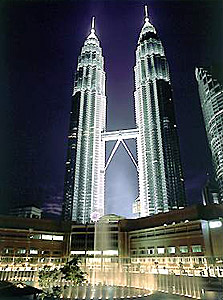 The decision was not without considerable
controversy, and remains so a decade later.
Stand Pelli’s towers side by side with Chicago’s Sears Tower, and the
reasons are clear. At 110 stories, Sears Tower puts people in offices at a
higher elevation than the 88-story Petronas. Yet the pointed top of the latter
soars higher, so the Sears lost the title.
The decision was not without considerable
controversy, and remains so a decade later.
Stand Pelli’s towers side by side with Chicago’s Sears Tower, and the
reasons are clear. At 110 stories, Sears Tower puts people in offices at a
higher elevation than the 88-story Petronas. Yet the pointed top of the latter
soars higher, so the Sears lost the title.
The ruling resulted in a new generation
of crowns and aerial extensions. But not all make a high-rise higher, at least
in the eye of the Council on Tall Buildings and
Urban Habitat, the official arbitrator of such matters. “The question has
always been, what comprises a tall building," concedes Ron Klemencic,
former director of the council.
After much debate, he says, the CTBUH
ruled that height would be measured from the ground to what is termed the
architectural top of a building. Masts and antennas are not counted, but certain
crowns, like those atop the Petronas, are allowed. "We felt, if the feature
is an integral part of the design, it should be included," Klemencic
explains.
The subjective decision didn’t stifle
grumbling, even amongst architects and engineers in the council. Debate
continued to rage over whether the Petronas Towers were truly taller, right
through 2004, when Taiwan’s soaring skyscraper, Taipei 101 came on line,
tickling the clouds at 509 meters.
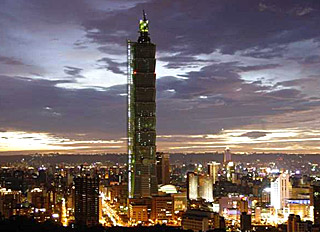 Taipei 101 remains the world’s tallest
building, but the question is for how long? Already a number of record-beating
contenders are on the rise. But it’s a safe bet that the new champion will
once again be in Asia, or the Gulf region.
Taipei 101 remains the world’s tallest
building, but the question is for how long? Already a number of record-beating
contenders are on the rise. But it’s a safe bet that the new champion will
once again be in Asia, or the Gulf region.
This is a huge shift, since the battle to build bigger, more elegant skyscrapers was essentially an American infatuation through the 20th Century, shaping the distinctive skylines of two great cities, New York and Chicago. Pelli’s twin towers changed the landscape in a flash, along with several other aspects of skyscraper construction.
Nowadays, big buildings are increasingly seen as defining statements for cities and countries. "There's a big difference in what drove big buildings in America in the 1950s and 1960s,” says Klemencic, a structural engineer who is managing director of Skilling Ward Magnusson Barkshire, and has worked on over 100 tall buildings in a dozen countries. “The race was to be big, but it was also about defining technology.”
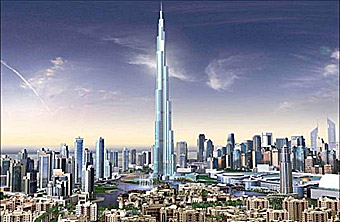 Nowadays, engineers and architects agree
there is a statement of power with each new erection. “The exposure that comes
from building the super-tall towers is undeniable," says Adrian Smith,
designer of many of them, including the enormous Burj in Dubai. Yet he adds that
big buildings can also generate value in establishing new destinations, as is
happening in Dubai and other neighboring Gulf states.
Nowadays, engineers and architects agree
there is a statement of power with each new erection. “The exposure that comes
from building the super-tall towers is undeniable," says Adrian Smith,
designer of many of them, including the enormous Burj in Dubai. Yet he adds that
big buildings can also generate value in establishing new destinations, as is
happening in Dubai and other neighboring Gulf states.
The other big change is the pace of
one-upmanship. Previously, tall buildings were rarer, reining supreme for
decades at a time. Now, with a dozen super skyscrapers rising simultaneously,
the frantic pursuit of bragging
rights means a tall building might be eclipsed within a few years..
Take the Petronas Towers, tipped by
Taipei 101 after only six years at the top of the charts. The previous champion
was Chicago’s Sears Tower (442 meters, or 1,450 feet) which reined for 25
years, after taking the title in 1974. Previously, New York’s Empire State
Building (381 meters, 102 stories) held the title for four decades.
These two American towers are the only
two non-Asian skyscrapers on the Top 10 list, and soon they will be gone,
replaced by towers rising around the region. Last year, all 10 of the world’s
new tall buildings were completed in Asia or the Gulf region. That a new
record-beater will emerge from this area is certain. But which? Where?
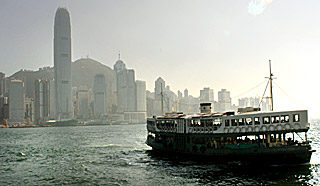 Hong Kong seemed a strong bet. Pelli’s
International Finance Center, a concrete clone of his Petronas creation, opened
on the waterfront of Central District in 2003, reshaping everyone’s opinion of
tall buildings in a city renowned for them.
Hong Kong seemed a strong bet. Pelli’s
International Finance Center, a concrete clone of his Petronas creation, opened
on the waterfront of Central District in 2003, reshaping everyone’s opinion of
tall buildings in a city renowned for them.
The 88-story, 415-meter tower became
Hong Kong’s tallest tower, and the world’s Number Six.
But as the IFC opened, construction
launched across the harbor on a tower designed to be Number One. Originally
planned to be 574 meters, the International Commerce Center has been scaled back
to 490 meters, which will make it tallest in Hong Kong, but the world’s Number
Three. However, it will have 118 floors, more than any other building on Earth,
with a lavish Ritz-Carlton Hotel on top, booking breathtaking rooms with unique
views.
That honor is currently claimed by the Grand Hyatt in Shanghai, offering world-topping views in the Jin Mao Building (88 stories, 421 meters), designed by Smith, then with Skidmore, Owings and Merrill (SOM), the same architectural firm responsible for the Sears Tower.
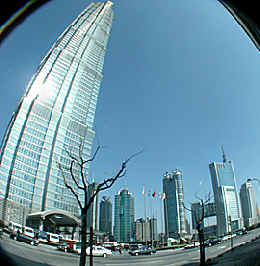 The Jin Mao sits in a cluster of
high-rises across the river from downtown Shanghai in the new financial district
of Pudong. Rising next door is World Financial Center, designed a decade ago by
Kohn Pedersen Fox (KPF) to be the world’s tallest. Although the project
stalled for years, it recently restarted, and given the new stakes in skyscraper
construction, it was scaled upwards. KPF president Eugene Kohn won’t say how
tall. “That's secret," he says, "but I guarantee it will be the
tallest."
The Jin Mao sits in a cluster of
high-rises across the river from downtown Shanghai in the new financial district
of Pudong. Rising next door is World Financial Center, designed a decade ago by
Kohn Pedersen Fox (KPF) to be the world’s tallest. Although the project
stalled for years, it recently restarted, and given the new stakes in skyscraper
construction, it was scaled upwards. KPF president Eugene Kohn won’t say how
tall. “That's secret," he says, "but I guarantee it will be the
tallest."
Perhaps, but not for long. Already, work is continuing on the Burj in Dubai, which takes the skyscraper race not only from Asia to the Gulf, but to staggering new heights. Designed by Smith, who has left SOM to found his own firm, Adrian Smith + Gordon Gill, the exact height is a closely-guarded secret. Yet Smith confides that it will top out at over 160 floors by 2009 at a breathtaking cost of over US$1 billion.
Just as the completion of the Petronas shifted tall-building construction to Asia last decade, the Burj signals the emergence of the Gulf region as a fertile ground for the next generation of mega-skyscrapers. The Burj towers above the rest, yet scores more high-rises are shooting up across the United Arab Emerites and nearby.
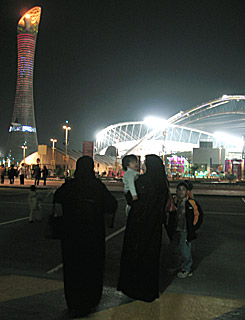 The world’s second tallest new building
last year was the Aspire Tower, part of a flurry of construction for the Asian
Games in Doha, Qatar. Three of the other Top 10 went up in Dubai. All the rest
were in China, Singapore, Japan and Australia.
The world’s second tallest new building
last year was the Aspire Tower, part of a flurry of construction for the Asian
Games in Doha, Qatar. Three of the other Top 10 went up in Dubai. All the rest
were in China, Singapore, Japan and Australia.
The Burj, though, begs new questions, namely, how high can buildings go?
"From a physics point of view, there is no limit," says Klemencic. Innovation has always hurdled mankind higher, from the invention of elevators in the mid-1800s, which took towers beyond the 10-story threshold, to development of steel that freed builders from the timeless task of piling bulky blocks of stone or concrete on top of each other.
Skyscrapers nowadays are usually skeletal structures of high-stress metal or mixed materials. Buildings are basically draped on beams that shift the weight and concentrated force of gravity to extensive underground substructures.
"The limitations are more financial and practical, how to move people up and down those great heights," says Klemencic. "Above 80 stories, the area you need to devote to vertical lift, like elevators, versus rent-able space just is not viable. Somewhere around 70-80 stories, the equation just stops making sense."
Yet, the equation keeps evolving, thanks to better engineering. The greatest advances have come in building materials and elevators. Shanghai's Jin Mao and Taipei 101 use high-speed elevators racing at 9 meters per second. As buildings grow taller, a porter system is used, lifting people in stages to landing areas and new elevators. To save space, double-decker elevators are employed, stacked on the same shaft.
Safety is also keen in people's minds, especially since the collapse of the World Trade Center. Clearly, materials will change with more emphasis on fire resistance. "This will remain on people's mind for some time," says Pelli. "We need to do sufficient things to make buildings safe."
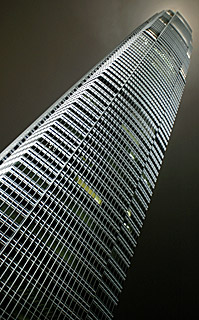 That's always been the battle as
buildings grew bigger. Take mitigation of movement. Early high-rises were stiff,
designed to resist storms. Skyscraper science long ago shifted to going with the
flow. Dampers, like shock absorbers in cars, take the hit from wind.
Asia adds new challenges, like typhoons.
That's always been the battle as
buildings grew bigger. Take mitigation of movement. Early high-rises were stiff,
designed to resist storms. Skyscraper science long ago shifted to going with the
flow. Dampers, like shock absorbers in cars, take the hit from wind.
Asia adds new challenges, like typhoons.
Hong Kong requires water tanks on roofs of tall buildings because of fire fears. Engineers have designed special tanks that let the water slosh about, doing double duty as a wind damper.
In the 1950s, Frank Lloyd Wright designed Illinois Building, soaring a mile high. That was considered a folly, but not anymore. Buildings up to 900 meters have been touted by architects like Sir Norman Foster. Given advances in construction, and the desire for statement skyscrapers, it’s only a matter of time before such heights are surpassed.
Many
bank on the Gulf as the region likely to claim the biggest towers for some time.
Credit not only the rising wealth, but also the terrain, where vast stretches of
land are available for new construction.
In a historical sense, it’s part of the
grand cycle of human construction. Building big began here, when humans started
piling up stone blocks, constructing pyramids.
"Humanity has an obsession with building big," says Pelli. "Part of it is the human element. That's why a tall TV tower isn't so important. When we see humans in a building, and know there are eyes up there, that's the emotional connection. Tall has power."
Ron Gluckman is an American reporter who has been working in Asia since 1990, visiting and often writing about the world's tallest towers and those who build them, for such publications as Popular Science, Geo, Asiaweek, the Wall Street Journal, Silk Road and the Urban Land Institute. This story appeared in the inflight magazine of Gulf Air in May 2007.
Photos: Top three descending - Petronas Towers, Taipei 101, Burj in Dubai -
from the web.
Bottom four - IFC and Hong Kong skyline, Jin Mao in Shanghai, Aspire Tower in
Qatar, and IFC again, by RON GLUCKMAN
To return to the opening page and index
push here
[right.htm]
